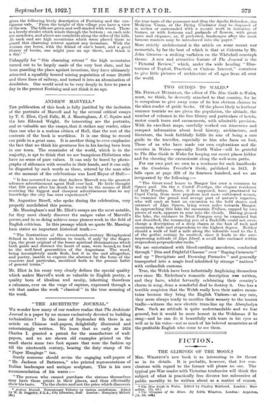TWO GUIDES TO WALES.*
Mx. FINDLAY MITIRHEAD, the editor of The Blue Guide to Wales, must, we think, be devoutly attached to that country, for he is scrupulous to give away none of its less obvious charms to the alien reader of guide books. Of the places likely to harbour
summer tourists we are given the population, the altitude, the number of volumes in the free library and particulars of hotels, motor coach tours and amusements, with admirable precision.
With its excellent maps, carefully worked out itineraries and compact information about local history, architecture, and literature, the book faithfully fulfils its aim of being a sure guide to the traveller, especially to him who fares on foot.
Those of us who have made our own explorations and dis- coveries in Wales—especially North Wales—will be grateful to The Blue Guide to Wales for keeping our secret places hidden and for cheering the excursionist along the well-worn paths.
For our own part we own to a weakness for such handbooks as the Cambrian Traveller's Guide, published in 1813. It falls open at page 326 of its fourteen hundred, and we art invigorated by the following :- " The Great-road hence to Bangor lies over a common to Ogwen pool. On the r. Casten Penrhyn, the elegant residence of lady Penrhyn. None, it is supposed, have penetrated to Capel Curig, from more populous and more cultivated scones, to examine the grand and savage part of nature's vagaries, who will omit at least an excursion to the bold shores and cataract of Llyn Ogwen, lying seven miles towards Bangor. In approaching this lake the mountain Trifaen, capped by two pieces of rock, appears to soar into the clouds. Having passed the lake, the entrance to Nant Frangon may be examined but not described, the romancing pen of a Radcliffe could not over- charge a description of a deep chasm at the foot of rock and mountain, rude and stupendous to the highest degree. Neither should a walk of half a mile along the tolerable road to the I. of the gothic cottage be omitted, since it leads to the awe- impressing solitude of Llyn Idwal, a small lake enclosed within stupendous perpendicular rocks. "
We are entertained with blood-curdling anecdotes, conducted through " Dim and Frightful Chasms " over " Raging Cataracts" and up " Precipitate and Frowning Pinnacles " and generally transported into a magic land inhabited by strange " natives " with outlandish customs.
True, the Welsh have been industrially Anglicizing themselves ever since Mr. Nicholson's romantic description was written, and they have, whilst fervently celebrating their country's charm in song, done a wonderful deal to destroy it. One has a terrible suspicion that the Welsh really love their native moun- tains because they bring the English Visitors—at any rate, they seem always ready to sacrifice their scenery to the tourist traffic—witness the new electric tram-line up the Aberglaslyn Pass. Such an attitude is quite understandable and we fear general, but it would be more honest in the Welshman if ho sang—and he can do it beautifully with tears in his eyes as well as in his voice—not so much of his beloved mountains as of the profitable English who come to see them.


































 Previous page
Previous page